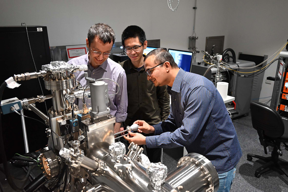Home > Press > New era of two-dimensional ferroelectrics: Reviewing layered van-der-Waals ferroelectrics for future nanoelectronics
 |
| From left, corresponding author Prof Jan Seidel (FLEET CI), lead author Dr Dawei Zhang, and corresponding author Dr Pankaj Sharma (FLEET Research Fellow), at UNSW
CREDIT UNSW |
Abstract:
A UNSW paper published recently in Nature Reviews Materials presents an exciting overview of the emerging field of 2D ferroelectric materials with layered van-der-Waals crystal structures: a novel class of low-dimensional materials that is highly interesting for future nanoelectronics.
New era of two-dimensional ferroelectrics: Reviewing layered van-der-Waals ferroelectrics for future nanoelectronics
Sydney, Australia | Posted on October 28th, 2022
Future applications include ultra-low energy electronics, high-performance, non-volatile data-storage, high-response optoelectronics, and flexible (energy-harvesting or wearable) electronics.
Structurally different from conventional oxide ferroelectrics with rigid lattices, van der Waals (vdW) ferroelectrics have stable layered structures with a combination of strong intralayer and weak interlayer forces (see figure).
These special atomic arrangements, in combination with the ferroelectric order, give rise to fundamentally new phenomena and functionalities not found in conventional materials.
Fundamentally new properties are found when these materials are exfoliated down to atomically thin layers, says author Dr Dawei Zhang. For example, the origin of the polarization and the switching mechanisms for the polar order can be different from conventional ferroelectrics, enabling new material functionality.
One of these materials most intriguing aspects is their easily stackable nature because of the weak van-der-Waals interlayer bonds, which means that vdW ferroelectrics are readily integrable with highly dissimilar crystal-structure materials, such as industrial silicon substrates, without interfacial issues.
This makes them highly attractive as building blocks for post-Moores law electronics, says author Prof Jan Seidel, also at UNSW.
From the perspective of applications and novel functionalities, vdW ferroelectrics present a wide range of opportunities for nanoelectronics owing to their easily obtainable ferroelectricity at the nanoscale, and dangling bonds-free, clean vdW interfaces that facilitate CMOS-compatible (current silicon technology) integration.
The new review discusses experimentally verified vdW ferroelectric systems and their unique characteristics, such as quadruple-well potentials, metallic ferroelectricity and dipole-locking effects. It also discusses engineered vdW ferroelectricity in stacks of otherwise nonpolar parent materials created by artificially breaking centrosymmetry.
Additionally, innovative device applications harnessing vdW ferroelectricity are showcased, including electronic transistors able to beat the fundamental thermodynamic limits, non-volatile memories and optoelectronic and flexible devices. Recent progress and existing challenges provide a perspective on future research directions and applications.
Its a relatively new field, so there are still many challenges that need to be solved to realize the full technological potential of these materials, says author Dr Pankaj Sharma. For example, we need to address large-area, uniform, wafer scale growth, and integration methods. These will allow development of futuristic low-energy electronics and computing solutions.
Given the recent emergence of vdW ferroelectrics, the materials library of such systems is quickly evolving. This leaves room for new developments, such as multiferroicity and coupled functionalities of multiple orders, for example ferroelectricity and magnetism, and the functionality of domain walls in such materials.
The authors acknowledge funding from the Australian Research Council (Discovery, LIEF and Centre of Excellence programs).
####
For more information, please click here
Contacts:
Errol Hunt
ARC Centre of Excellence in Future Low-Energy Electronics Technologies
Office: 042-313-9210
Copyright © ARC Centre of Excellence in Future Low-Energy Electronics Technologies
If you have a comment, please Contact us.
Issuers of news releases, not 7th Wave, Inc. or Nanotechnology Now, are solely responsible for the accuracy of the content.
News and information
![]()
Kagome metallic crystal adds new spin to electronics October 28th, 2022
![]()
Improving the efficiency of nanogenerators that harvest static electricity October 28th, 2022
![]()
Advanced Materials and NanoSystems: Theory and Experiment-Part 1 & 2 October 28th, 2022
![]()
Current and Future Developments in Nanomaterials and Carbon Nanotubes: Applications of Nanomaterials in Energy Storage and Electronics October 28th, 2022
2 Dimensional Materials
![]()
Synthesis of air-stable room-temperature van der Waals magnetic thin flakes September 30th, 2022
![]()
New road towards spin-polarised currents September 9th, 2022
![]()
Buckyballs on gold are less exotic than graphene July 22nd, 2022
Magnetism/Magnons
![]()
Nanomagnetic computing can provide low-energy AI, researchers show May 6th, 2022
Possible Futures
![]()
Advanced Materials and NanoSystems: Theory and Experiment-Part 1 & 2 October 28th, 2022
![]()
Current and Future Developments in Nanomaterials and Carbon Nanotubes: Applications of Nanomaterials in Energy Storage and Electronics October 28th, 2022
Chip Technology
![]()
Kagome metallic crystal adds new spin to electronics October 28th, 2022
Discoveries
![]()
Scientists have proposed a new material for perovskite solar cells: It is cheaper its analogues, easier to manufacture and to modify October 28th, 2022
![]()
Kagome metallic crystal adds new spin to electronics October 28th, 2022
![]()
Improving the efficiency of nanogenerators that harvest static electricity October 28th, 2022
Announcements
![]()
Scientists have proposed a new material for perovskite solar cells: It is cheaper its analogues, easier to manufacture and to modify October 28th, 2022
![]()
Kagome metallic crystal adds new spin to electronics October 28th, 2022
![]()
Improving the efficiency of nanogenerators that harvest static electricity October 28th, 2022
![]()
Advanced Materials and NanoSystems: Theory and Experiment-Part 1 & 2 October 28th, 2022
Interviews/Book Reviews/Essays/Reports/Podcasts/Journals/White papers/Posters
![]()
Scientists have proposed a new material for perovskite solar cells: It is cheaper its analogues, easier to manufacture and to modify October 28th, 2022
![]()
Improving the efficiency of nanogenerators that harvest static electricity October 28th, 2022
![]()
Advanced Materials and NanoSystems: Theory and Experiment-Part 1 & 2 October 28th, 2022
![]()
Current and Future Developments in Nanomaterials and Carbon Nanotubes: Applications of Nanomaterials in Energy Storage and Electronics October 28th, 2022










